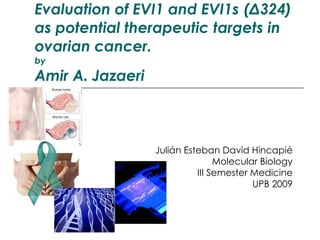
Evaluation of EVI1 and EVI1s (δ324) by Julian David Hincapie
- 1. Evaluation of EVI1 and EVI1s (Δ324) as potential therapeutic targets in ovarian cancer. by Amir A. Jazaeri Julián Esteban David Hincapié Molecular Biology III Semester Medicine UPB 2009
- 16. Figura 2. EVI1 mRNA expression Evaluation of EVI1 and EVI1s (Δ324) as potential therapeutic targets in ovarian cancer.
- 17. Figura 2A Evaluation of EVI1 and EVI1s (Δ324) as potential therapeutic targets in ovarian cancer. . (A) Semi-quantitative RT-PCR revealed higher EVI1 and EVI1s expression in serous epithelial ovarian cancers compared to normal ovaries. Identity of EVI1and EVI1swas verified by cloning and DNA sequencing. In addition other lower expressed cDNA bands were alsoamplified and identified as EVI1 transcript variants using siRNA(panel C). Negative control experiments consisted of omission of reverse transcriptase and RNA and resulted in no amplified PCR product.
- 18. Figura 2B Evaluation of EVI1 and EVI1s (Δ324) as potential therapeutic targets in ovarian cancer. (B) EVI1 transcripts are also expressed in a number of established ovarian cancer cell lines aswell as the H118 immortalized ovarian surface epithelial cells. The CAOV3 and OVCAR8 ovarian cancer cell lines had no detectable EVI1mRNA.
- 19. Figura 2C Evaluation of EVI1 and EVI1s (Δ324) as potential therapeutic targets in ovarian cancer. (C) Knockdown of EVI1 using siRNA directed against the region spliced out in EVI1s results in degradation of EVI1 as well as the other minor transcripts.
- 20. Figura 3. EVI1 isoform protein expression Evaluation of EVI1 and EVI1s (Δ324) as potential therapeutic targets in ovarian cancer.
- 21. Figura 3A Evaluation of EVI1 and EVI1s (Δ324) as potential therapeutic targets in ovarian cancer. (A) Using the SKOV3 ovarian cancer cells as a representative model, 185, 145, and 90 kDa bands corresponding to MDS-EVI1 (ME), EVI1, and EVI1s, respectively, were identified and their identities confirmed using isoform selective siRNA. Oligonucleotides A, B, C, and 03 target regions of the EVI1 open reading frame common to all isoforms and exhibited varying degrees of knockdown. SiB reproducibly provided greater than 90% knockdown of all EVI1 isoforms. Si04 targets sequences spliced out in EVI1s and hence results in isoform-selective knockdown of EVI1 and ME. Si 2Kb targets the splice junction uniquely used in EVI1s and thus selectively inhibits this isoform.
- 22. Figura 3B Evaluation of EVI1 and EVI1s (Δ324) as potential therapeutic targets in ovarian cancer. (B) Immunoblot demonstrating the expression of ME, EVI1, and EVI1s in 10 serous ovarian cancer samples. SKOV3 cells and OVCAR8 EVI1 null cells expressing exogenous EVI1 and EVI1s were included to facilitate isoform identification.
- 23. Figura 3C Evaluation of EVI1 and EVI1s (Δ324) as potential therapeutic targets in ovarian cancer. (C) Western blot of a representative set of serous ovarian cancers (C), normal postmenopausal ovary (O), fallopian tube fimbria (F), and benign ovarian neoplasms (B).
- 24. Figura 4. Retroviral expression of EVI1 and EVI1s in OVCAR8 cells Evaluation of EVI1 and EVI1s (Δ324) as potential therapeutic targets in ovarian cancer. (A) RT-PCR demonstrating the expression of Evi1 and EVI1s mRNA in OVCAR 8 infected cells compared to uninfected OVCAR8 and SKOV3 cells. (B) Expression of recombinant EVI1 and EVI1s in OVCAR 8 cells.
- 25. Figura 6. Effects of EVI1 protein isoforms on ovarian cancer proliferation Evaluation of EVI1 and EVI1s (Δ324) as potential therapeutic targets in ovarian cancer.
- 26. Figura 6A Evaluation of EVI1 and EVI1s (Δ324) as potential therapeutic targets in ovarian cancer. (A) Isoform selective depletion of EVI1 proteins using siRNA.
- 27. Figura 6B Evaluation of EVI1 and EVI1s (Δ324) as potential therapeutic targets in ovarian cancer. (B) Levels of basal and daunorubicin-induced double-stranded DNA breaks as indicated by γ -H2AX immunoblotting following EVI1 isoform knockdown.
- 28. DISCUSSION Evaluation of EVI1 and EVI1s (Δ324) as potential therapeutic targets in ovarian cancer. No A recent investigation implicated 3q26 copy number alterations and possibly EVI1 expression in ovarian cancer chemoresistance. It is noteworthy that in this study only EVI1 mRNA expression was evaluated using primers that do not differentiated between various EVI1 and ME transcripts. Osterberg L et al. Yes Potential oncogenic action of SnoN/SkiL, a coregulator of SMAD/TGF beta signaling that maps to 3q26.2 has been recently reported by the same group of investigators that published one of the reports on EVI1 in ovarian cancer. Najundan M et al. Yes ME and EVI1 forced expression increased the growth of an immortalized ovarian surface epithelial cell line. Interestingly however, they also observed no effects on growth of OVCAR8 ovarian cancer cells. Najundan M et al. Yes Reported a positive correlation between EVI1 immunohistochemical staining and mRNA levels, though they did not present any immublotting data and their methods precluded differentiating between ME, EVI1, and EVI1s transcripts. Sunde JS et al. Coincidence Yes/No Approach Scientist
- 31. Thank you!
- 32. Hecho por: Julián David Hincapié
